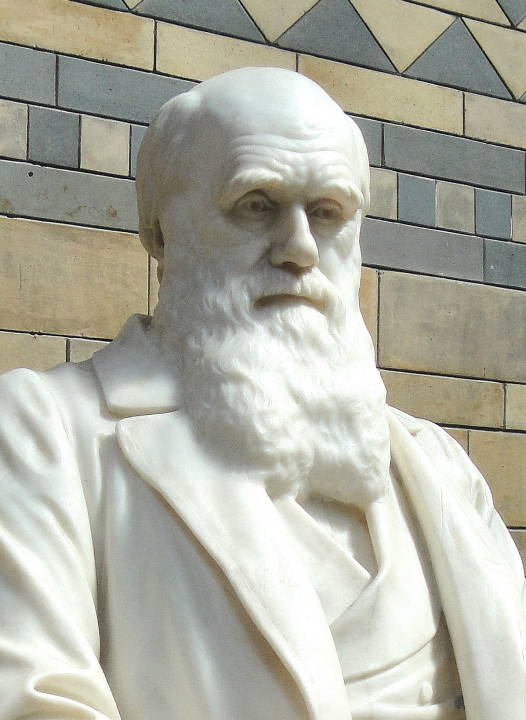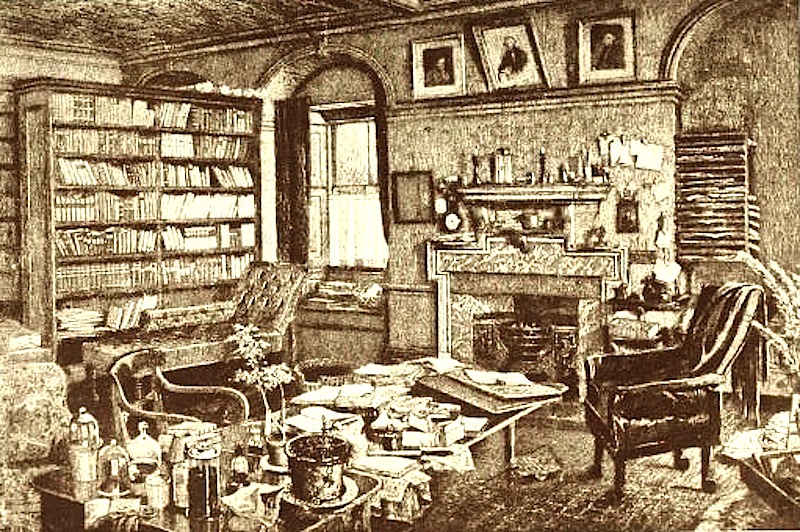This review is reproduced here by kind permission of H-Museum, which first published it in 2009. The original text has been reformatted and illustrated for the Victorian Web by Jacqueline Banerjee, who has also added captions and links. Click on the images to enlarge them, and sometimes for more information about them.

Charles Darwin, by Sir Edgar Boehm, at the Natural History Museum.
In these troubled times when "religious fundamentalists" of all kinds, especially in the United States, join the Alaskan-based society of Flat Earthers in denying scientific evidence – this time on the age of the earth and the origin of animal (including Home Sapiens) life – the organization of a major "Darwin retrospective" on the occasion of the bicentenary of his birth in 1809 must have been both a great pleasure and a sensitive decision for the curators of the prominent museums which are behind it: the American Museum of Natural History; the Museum of Science, Boston; the Field Museum, Chicago; the Royal Ontario Museum, Toronto; and the Natural History Museum, London.

Alfred Waterhouse's Natural History Museum, Cromwell Road, London.
The website of London's Natural History Museum – which is the last stage in its world tour – adopts a low profile on the subject, but the actual Exhibition has an unambiguous militant tone: all subsequent research has proved Darwin right and his obscurantist critics and deniers wrong. All the distinguished (mostly American) scientists who appear on videos agree: a scientific theory will always remain a theory because it can be disproved at any time by new discoveries which are impossible to reconcile with it. The extraordinary thing in Darwin's theory of Evolution (which he was not the first to propound, but the first to justify by rational explanations drawing on observation of the natural world) is that it has stood the test of time ever since he drew that famous "evolutionary tree" on one of his numerous sketchbooks in 1837 – the formal book, On the Origin of Species by means of Natural Selection, or the Preservation of favoured Races in the Struggle for Life only appearing in 1859 ("1250 copies published all sold the first day," an autograph mention tells us on the end papers of the original copy displayed). Indeed, if anything, a fascinating section shows, the modern theories on DNA could not have been built without the foundations provided by Darwin – and they thereby reinforce the validity of his work.

Darwin's Tree, over which is written in his notebook, "I think." His thoughts here were: "Thus between A and B immens[e] gap of relation, [between] C and B the finest gradation, [between] B and D rather greater distinction. Thus genera would be formed, — bearing relation | to ancient types, — with several extinct forms." Source: Bulletin, 46).
The Exhibition follows a broadly chronological course, starting with Darwin's comfortable youth and the negotiations with his father to obtain permission – and money – to join the Beagle expedition (1831-1836). A re-creation of the various living animals and fossils which sustained his lifelong enthusiasm for scientific observation and description is offered, many exhibits coming from the American Museum of Natural History. A live green iguana baptized Charlie reminds the visitor that one of the great elements in evolution is adaptation to the environment – a point which "Charlie" perfectly makes. Stuffed mockingbirds which Darwin brought back from the Galapagos Islands also illustrate his original questioning of the differences which he observed in them – and in the giant tortoises which he enjoyed riding as a playful young man. Naturally, a large map of his voyage is provided.
Most revealing to the lay visitor, however, are not differences inside species but the "invisible" similarities between widely different species of animals which Darwin examined, trying to find a rational explanation for them. The resemblance between orangutans / chimpanzees and humans was of course a well-known fact, commercially exploited in circuses and zoos. An orangutan called "Jenny" was popular in Darwin's time for her human-like mimicry. But what had a bat and a human in common? Nothing in appearance – but their skeletons showed that the human hand with its five articulated fingers was remarkably similar to the "phalanxes" found in the five "fingers" which formed the structure of the bat's wings. From the notebooks, letters, manuscripts and other written documents shown, it is clear that Darwin was aware of the seismic nature of his theory of evolution by natural selection (he spoke of a "considerable step in science" in a note which he wrote to his wife in 1844, instructing her to publish an essay which made the case for it in the event of his premature death) – and also aware that it was in total contradiction with the account in Genesis, at a time when religion dominated British society (his own wife being extremely pious). In the same year, he wrote to a colleague that arguing his case was "like confessing a murder."

Darwin's study at Down, Kent. From an etching by Axel Haig. Source: Darwin, facing p. 416.
The section devoted to his agonizing hesitations over publishing or not publishing ends with a very effective reconstruction of his study, with some of his final publications – his hand had eventually been forced by events, with a younger researcher, Alfred Russel Wallace, about to publish a theory of evolution on the lines of Darwin's earlier semi-secret findings. This was 1858 – from then on Darwin "went open." The Origin of Species did not mention the human species, though everything in it suggested that humans were no exception. Prominent churchmen like Bishop Samuel Wilberforce immediately led a frontal attack against the content of the book, showing that they had understood the issue at stake. But Darwin did not flinch, making the link with humans explicit in 1871, with The Descent of Man, and Selection in Relation to Sex.
"Darwinism" was by now well established in the scientific community – prominent naturalists like Thomas Huxley taking the lead in the propagation of the new theories. The last section is devoted to their legacy – the refutation of "Creationist" views by leading contemporary scientists (with wall texts derived from the 2005-2006 New York Exhibition - we learn that in 1925 Tennessee made it a misdemeanour for public school teachers to teach evolution), the latest breakthroughs of DNA research and a "library" of Darwin's works in all conceivable languages. A large superb "genealogical" display of prehistoric humanoid (human?) skulls dated thanks to the latest techniques ("cladogram") constitutes a fitting final counterpoint to Darwin's first tiny little sketch of his "tree" explaining evolution. "I think," he had modestly written above this capital graphic hypothesis. He thought right – his hypothesis still holds after over 170 years, and this very well staged Exhibition does it full credit.
Related Material
- (Offline) The Alaska-based website of the Flat Earth Society
- (Offline) American Natural History: Past Exhibitions: Darwin
- Darwin's Imagery — The Tree and the Tree of Life
- Samuel Wilberforce's Review of Darwin's The Origin of Species, 1860
- An Historical Sketch Of The Progress Of Opinion On The Origin Of Species
- The Descent of Man, and Selection in Relation to Sex (book and short commentary)
Sources of Illustrations
Bulletin of the British Museum (Natural History). Historical Series Vol. 2 (1953-1963). London: Trustees of the British Museum (Natural History), 1969. Internet Archive. Contributed by the Natural History Museum. Web. 31 October 2014.
Darwin, Charles. The Origin of Species. New York: P. F. Collier, c.1909. Internet Archive. Contributed by the Kelly Library, Univeristy of Toronto. Web. 31 October 2014.
Last modified 1 November 2014